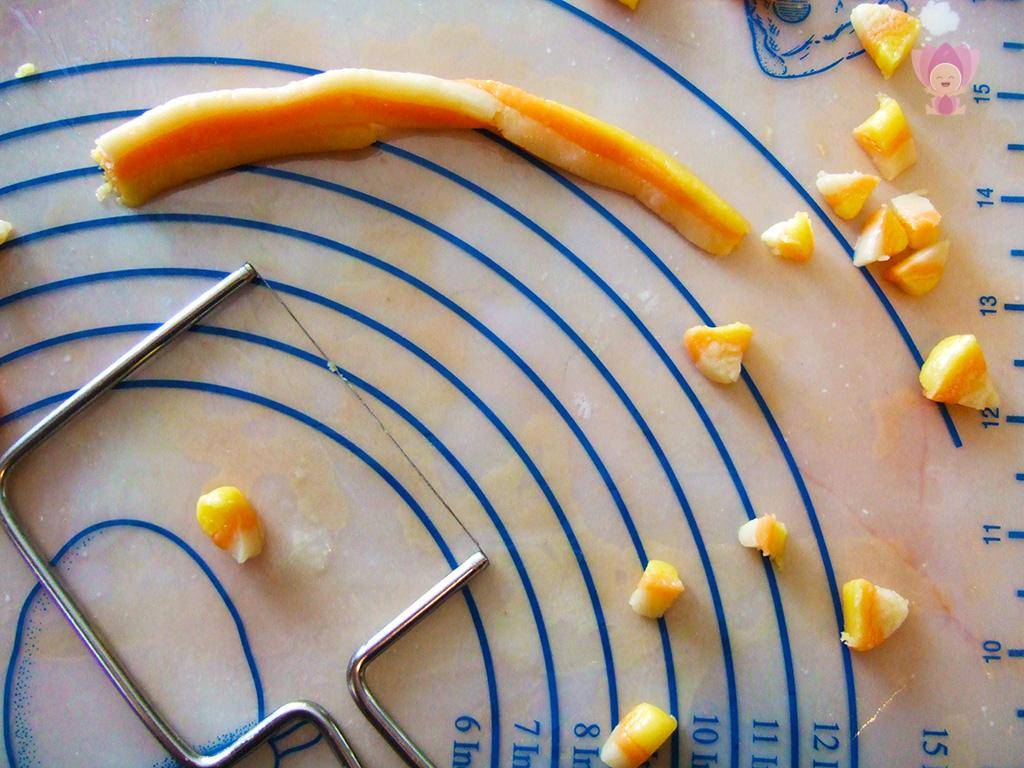Why Do We Eat Candy Corn on Halloween

Candy Corn: love it or hate it, and you’ll only be right if you hate it. Just kidding. Even though I don’t personally like this seasonal treat, I’ve gained a greater appreciation for it after digging into its history–as the First Halloween Candy ever created. It’s story is tied with the evolution of modern Halloween celebrations, which are not as old as you may think.
Candy Corn on Halloween
Halloween became popular holiday in America around the turn of the 20th century. It was celebrated at home with a festive theme party, with spooky decorations and refreshments. The occasion could be for kids–but not necessarily. The Book of Hallowe’en, published in 1919, gives us a sense of what these parties were like:
For the centerpiece of the table there may be a hollowed pumpkin, filled with apples and nuts and other fruits of harvest, or a pumpkin-chariot drawn by field-mice… Jack-o’-lanterns, with which the room is lighted, are hollowed pumpkins with candles inside… Corn-stalks from the garden stand in clumps about the room. A frieze of witches on broomsticks, with cats, bats, and owls surmounts the fireplace, perhaps…The prevailing colors are yellow and black: a deep yellow is the color of most ripe grain and fruit; black stands for black magic and demoniac influence.
Having marched to the dining-room to the time of a dirge, the guests find before them plain, hearty fare; doughnuts, gingerbread, cider, popcorn, apples, and nuts honored by time. The Hallowe’en cake has held the place of honor since the beginning here in America. A ring, key, thimble, penny, and button baked in it foretell respectively speedy marriage, a journey, spinsterhood, wealth, and bachelorhood.
Notice that although there are sweets like doughnuts and a Halloween cake mentioned among the food, there is no candy, let alone candy corn. At the turn of the century, despite the fact there was themed candy for every other holiday (including marzipan cherries for Washington’s birthday), candy companies didn’t see Halloween as a candy-oriented holiday. Desperate for a way to boost fall candy sales, “Candy Day” was invented, a day where you…buy candy. Later to be known as “Sweetest Day,” it’s the second Saturday of October and still celebrated in some areas, like my hometown of Cleveland.
Created around 1880, candy corn was not originally considered a Halloween sweet. Better known at the time as “chicken feed,” which I think is a very cute name, it was manufactured year-round and was especially popular for the Fourth of July and in Easter baskets. But with its harvest-festival colors of yellow, orange and red it also seemed a natural fit for fall celebrations, and was slowly integrated into Halloween parties. From The Atlantic:
Candy-making oral tradition credits the invention of candy corn to George Renninger, a candy maker at the Wunderle Candy Company of Philadelphia…At that time, many candy makers were producing “butter cream” candies molded into all kinds of natural or plant-inspired shapes, including chestnuts, turnips, and clover leaves. The real innovation in candy corn was the layering of three colors. This made it taxing to produce (all those colors had to be layered by hand in those days). But the bright, layered colors also made the candy novel and visually exciting.
Although candy corn was the first candy to be integrated into Halloween, it wasn’t until after WWII that candy companies started manufacturing Halloween themed candy in appropriate Jack-o-Lantern shapes and fall colors. Conversely, Brach’s, established in 1904, is now doing its best to detach candy corn from its Halloween-only image, by producing new flavors like “Milk Maid Caramel Candy Corn” and manufacturing different seasonal colors like red and green.

Making Candy Corn on Halloween
Slicing up the candy corns with my Velveeta Cheese Slicer. Handy!
Making Candy Corn
I’ve never liked candy corn, but I decided to give them a second chance after I stumbled across Alton Brown’s recipe for “chicken feed” from scratch. It blends butter and powdered milk (I used Bob’s Red Mill Non Fat Dry Milk Powder, 22-ounce) with boiled sugar. There is a bit of a learning curve with this recipe: the first time I made it, the dough turned out unusable, flaky, and weird. The second time, I was more precise: I measure my ingredients by weight instead of volume and boiled the sugar at a lower temperature.

Photo (c) Sarah Lohman
Although the sugar boiling should be done by an adult, once the candy cools enough to work with, layering the colors and cutting the shapes is a great activity for kids.
Although my candy corns (pictured above) turned out looking very handmade, I find them endearing. And they taste waaay better than store-bought: they creamy and tart, as well as sweet and salty–a complexity of flavor that can only come from handmade.
________

Sarah Lohman
















Leave a comment